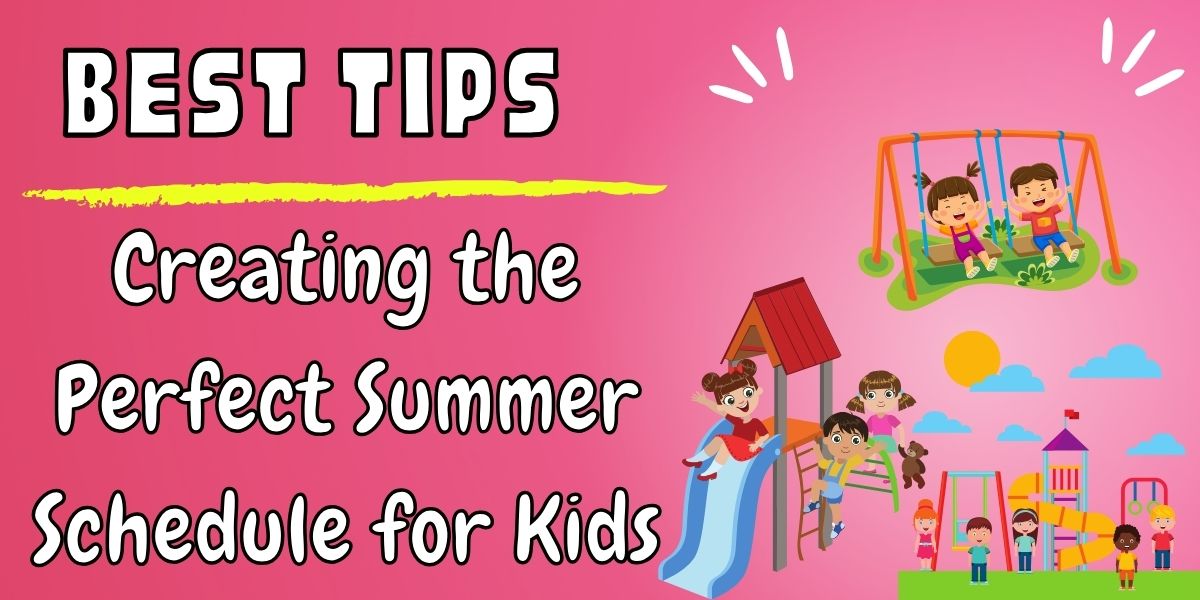Summer is a magical time for kids, brimming with endless possibilities. However, without a structured schedule, the summer can quickly become overwhelming or underwhelming—either packed with too many activities or plagued by boredom.
Crafting the perfect summer schedule for kids is essential for balancing fun with educational activities, ensuring their physical and mental well-being during these carefree months.
How to Design a Flexible Yet Structured Summer Schedule

Creating a summer schedule that’s both flexible and structured might sound contradictory, but it’s key to making the most out of summer. Here’s how to achieve this balance:
- Incorporate Outdoor Play and Physical Activities: Encourage physical health and exploration by prioritizing outdoor play. Whether it’s a daily family walk, bike rides, or swimming, make sure your kids are moving and soaking up some vitamin D.
- Balance Educational and Fun Activities: Summer learning loss is a real phenomenon. Combat it by integrating educational activities that don’t feel like homework. Think science experiments, math games, or language-learning apps that are fun and engaging.
- Schedule Daily Reading or Learning Time: Dedicate a quiet time for reading each day. This can be a mix of self-chosen books and educational materials that support their learning.
- Allow for Free Play and Rest Periods: It’s important to not overschedule. Kids need time to engage in unstructured play, where they can use their imagination and unwind. Equally, rest is vital, so ensure there’s downtime in their day.
Summer Activities for Kids to Include in the Schedule

Filling the summer schedule with enriching activities is the next step. Here are a few ideas:
- Local Summer Camps and Day Programs: These can be great for socialization and learning new skills. Look for camps that align with your child’s interests, whether it’s sports, music, or science.
- Family-Friendly Outdoor Adventures: Plan visits to local parks, beaches, or hiking trails. These adventures can be both fun and educational, offering opportunities to learn about nature and wildlife.
- DIY Arts and Crafts Projects: Set aside time for creativity. Arts and crafts projects can be as simple as coloring, or as complex as building a birdhouse. The key is to inspire creativity and hands-on learning.
- Educational Games and Activities: There are countless educational games available online that make learning fun. Choose activities that reinforce what they’ve learned during the school year or introduce new topics of interest.
Summer schedule for kids samples:
Here are two sample summer schedules for kids that incorporate the tips and activities mentioned above:
Sample 1:
| 8:00 AM | Breakfast |
| 9:00 AM | Outdoor Play (bike ride, walk, or pool time) |
| 10:30 AM | Educational Game or Learning Activity |
| 11:30 AM | Lunch |
| 12:30 PM | Quiet Reading Time |
| 2:00 PM | DIY Arts and Crafts Project |
| 3:30 PM | Free Play |
| 5:00 PM | Dinner |
| 6:00 PM | Family Outdoor Adventure (hike, beach trip, etc.) |
| 8:00 PM | Wind Down and Bedtime Routine |
Sample 2:
| 8:30 AM | Breakfast |
| 9:30 AM | Local Day Program or Summer Camp |
| 12:00 PM | Lunch and Rest Period |
| 1:30 PM | Educational or STEM Activity (science experiments, coding, etc.) |
| 3:00 PM | Free Play or Outdoor Exploration |
| 5:00 PM | Dinner |
| 6:30 PM | Family Movie Night or Game Night |
| 8:30 PM | Bedtime Routine |
Tips for Engaging Kids in Their Summer Schedule
To ensure your summer schedule is a success, consider these strategies:
- Involving Kids in the Planning Process: This gives them a sense of ownership and makes them more likely to be enthusiastic about their summer activities.
- Setting Achievable Goals and Milestones: Whether it’s finishing a book or learning a new skill, setting goals helps kids stay motivated throughout the summer.
- Using Visual Schedules and Checklists: Visual aids can help kids understand what’s planned for the day and week, making it easier for them to follow the schedule.
Summer camp for kids ideas:

If summer camps and day programs are a regular part of your child’s summer schedule, here are some ideas to consider:
- STEM Camps: These camps focus on science, technology, engineering, and math, offering hands-on learning experiences through experiments and projects.
- Art Camps: For the creative kids, art camps offer a range of activities such as painting, sculpting, and drawing.
- Adventure Camps: Kids can learn new skills like rock climbing, backpacking, or kayaking while exploring the great outdoors.
- Sports Camps: Perfect for the athletic child, these camps offer a variety of sports activities such as basketball, soccer, and swimming.
The Importance of Consistency and Flexibility in the Summer Schedule

While having a schedule is important, being too rigid can lead to frustration. Here’s how to maintain the right balance:
- Staying Consistent with Wake-Up and Bedtime Routines: Consistent sleep schedules are important for kids’ health. Try to keep wake-up and bedtime routines similar to the school year to avoid a difficult transition back to school.
- Being Flexible to Accommodate Spontaneous Activities or Changing Weather: Sometimes, an unexpected opportunity for fun will arise, or plans will need to change due to weather. Being flexible ensures that these changes don’t disrupt the overall flow of summer.
Conclusion
A well-balanced summer schedule can significantly enhance a child’s physical, mental, and emotional well-being. By incorporating a mix of educational, creative, and physical activities—and allowing for downtime—you can ensure your kids have a summer that’s both enriching and enjoyable. Remember, the goal isn’t to fill every moment with activity, but to provide a framework that encourages a healthy, happy, and balanced summer break.
You might also be interested in:
How To Get Your Kids To Listen Without Yelling

